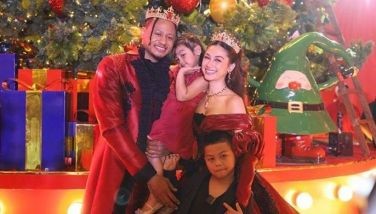Feature story: A to Z Chinese New Year Guide
CEBU, Philippines - Today, the world’s Chinese community will be say goodbye to the dragon as it shed’s off its scales revealing a black water snake within.
Allow us to give you a rundown to some of the more common Chinese traditions, food, beliefs, and superstitions most prevalent during this most auspicious day of the Chinese calendar.
Apples and dried apricots are not just served and offered to visitors and friends, but are also offered to the family’s ancestors and gods. Apples symbolize peace and wisdom, while apricots bring wealth.
Bamboo shoots are served during the Chinese New Year season. Its Chinese term, zhu sun jian, sounds like a wish for wealth and a new start.
Chicken, duck, or fish dishes are a common sight in many Chinese tables during this season. Fish, for one, should be served whole as it represents togetherness, and so with the chicken, for prosperity.
Dragon dance is performed by a team of dancers with the dragon held on poles. It is believed that the dragon brings good luck, and it is for this reason that aside from the celebration of the Chinese New Year, dragon dances are also performed at the opening of business establishments.
Eight treasure rice is a traditional dessert served on the seventh day of the Chinese New Year season. This is a sweet dish made of glutinous rice and eight kinds of dried fruits. Although no two eight treasure rice is the same, the most common fruits used are dates, lotus seeds, red and green plums, cherries, orange, red bean paste, and raisins.
Firecrackers are a must when greeting the Chinese New Year. They say the louder the firecrackers, the better, although, for safety reasons, it is better to leave this part of the festivity to the experts. The loud noise of the firecrackers is believed to help chase away last year’s bad luck while attracting the attention of the God of Good Fortune and Wealth.
Ghost stories are a big “no†during the Chinese New Year season, and so are talks of death and dying. Rather, prefer to attract good vibrations by sending good wishes and talking of good things and blessings.
Hong bao (Mandarin) or Ang pow (Hokkien) is a red envelope filled with money and is given to children or unemployed young adults. This symbolizes good will, good luck, and good fortune.
Improve your financial health by paying off your debts. The Chinese believes that if you start your year in debt, you will live the rest of your year in debt.
Jie Cai Ceng is the fifth day of the Chinese New Year. It is believed that on this day, the gods of prosperity, Cai Shen, descends from the heavens. The gods of wealth and prosperity are greeted with a feast of dumplings and firecrackers.
Kumquat or kiat-kiat is a small citrus fruit displayed during the New Year season to attract good luck and good fortune. These are the most common gifts when visiting friends and family during the New Year season.
Lion dance is more or less the same as the dragon dance, but instead of the dragon, dancers use the lion. The main difference is that with the lion dance, there are only two dancers and they are rarely seen as they are part of the lion.
Mixed vegetables symbolize harmony in relationships. A famous Chinese-Singaporean traditional salad is yee sang or yu sheng, which is tossed fresh vegetables, fruits, and fresh fish. Tossing yee sang ensures good luck, prosperity, and good health for all those who participate in the tossing.
Niangao or tikoy is glutinous rice cake and eating it during the Chinese New Year is considered good luck. The cake can be eaten as is or in the country, it is popularly dipped in egg and then fried. Usually, this is given as a gift to family and friends to promote togetherness.
Oranges with leaves intact is a great gift to friends and family during the Chinese New Year season. For starting families, receiving a bag of oranges with their leaves intact is considered favorable as it symbolizes the giver’s wish for the family to have many children.
Pineapple is said to be the best fruit to stock on when greeting the snake. The fruit symbolizes wealth, luck (including gambling luck), and fortune.
Qipao or cheongsam is a traditional Chinese dress. Its male version is the changpao. The dress was popular in the late 1600s but is now worn only during formal occasions. Get into the festival mood and get one of these stylish dresses in red.
Red is definitely the color of the season. In Chinese culture, red is the color of good luck, so it is never a bad idea to overdo on the red. Stock up on red clothes, red fashion accessories, and everything and anything red.
Song gao or loose cake is made of rice flour, sugar, water, and azuki beans. It is decorated with a variety of fruits and nuts including pine nuts, walnut, dates, mint, lotus seed, and others. The cake symbolizes blessings and is usually given to family and friends.
Tangyuan is usually eaten during the lantern festival to promote family togetherness. Tangyuan is made of glutinous rice mixed with a little water and then rolled into a ball. This is then cooked and served in boiling water.
Unload the dirt on the day before the start of the New Year, and on New Years Eve, all cleaning implements should be put away and hidden from sight. On New Year’s Day, sweeping and cleaning is forbidden as it is believed to also sweep away the good fortune, but after that, the floors can be swept but the dirt can only be taken out of the house on the fifth day of the New Year celebration.
Vegetarian dishes are served on the thirteenth day of the Chinese New Year season. This is to cleanse the body of the toxins from consuming too much meat in the last weeks.
Wan Shi Ru Yi. Let’s expand your Chinese New Year greeting from merely Kung Hei Fat Choi (Congratulations and be prosperous!), to also include Wan Shi Ru Yi, which means “May all your wishes be fulfilled.â€
Xiangjiao or banana is used as an altar offering when one asks for better education and good work performance.
Yuan xiao jie or the lantern festival is celebrated on the 15th day of the Chinese New Year season. It falls on the night of the first full moon of the Chinese calendar, marking the end of the New Year season. Traditionally yuanxiao dumplings or sticky rice with sweet or savory fillings is served on this day. This year it falls on February 24.
Zha doufu or fried tofu looks like gold nuggets and therefore symbolizes wealth. It is not only served together with other dishes during the New Year feast, but is also used to offer to one’s ancestors and gods.
So, do you still feel like you are missing on something for this year’s Chinese New Year celebration? Check out the ABCs and you would be as close to complete as you could possibly be.
Kung hei fat choi!
- Latest


























